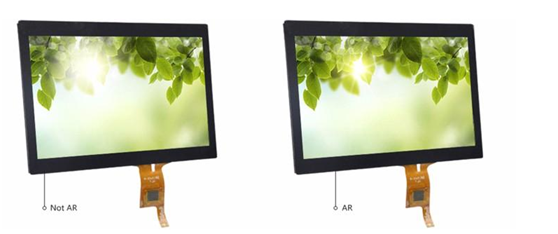What is AR glass?
Date:2023-12-13
AR glass is also called reducing reflected glass/moisturizing glass. By
using the world's most advanced magnetic sputtering coating technology, the
upper layer of reducing reflective membrane is placed on the ordinary
strengthening glass surface, which effectively reduces the reflection of the
glass itself. The light transmission rate of the glass is improved, so that the
color of the original glass is more vivid and more real.

First, we need to understand the basic principles of light. As an
electromagnetic wave, when it encounters the interface of the medium, reflection
and refraction will occur. When the light enters another medium from ones,
refracting will occur. When the light encounters a surface, some light will be
reflected back. Generally, the surface of glasses or electronic devices will
have a thin layer of oxidation layer, which can cause light reflection. The AR
glass can reduce this reflection through a series of processes.
The core principle of AR glass is to use refractive index differences to
offset reflection. Specifically, AR glass achieves this by coating a layer of
film on the glass surface. The refractive index of this thin film is lower than
that index of the glass, which makes the light refraction multiple times between
the surface and the film, thereby reducing the number of reflexes.
This film is usually composed of multiple nano -level film. The thickness
of each nanometer -level film is very accurate to ensure that the light on a
specific wavelength has the best refractive effect. The vertical interconnection
between these nano-class film can minimize reflexes and make more light through
the glass surface.
However, AR glass does not have only one layer of film, usually with
multiple layers of stacking design. Each layer of film is optimized for specific
wavelengths to minimize reflection. This multi -layered design can make AR glass
have good reflection attenuation effects in different wavelengths.
In addition to the use of refractive index differences to reduce
reflection, AR glass also has another important principle, that is, the
interference effect of light. When light passes through a multi -layer thin film
structure, the light of different wavelengths will interfere. The interference
effect will enhance the light of some wavelengths, and the light of other
wavelengths weakens.
This feature enables AR glass to achieve better reflection inhibitory
effects on a specific wavelength. By careful selection and design of the
thickness and materials of the film, you can optimize AR glass to minimize the
reflection on a specific wavelength.
In short, AR glass reduces reflection by using refractive index differences
and light interference effects, and realizes anti -reflection function. Its
multi -layered stack design can provide good reflection attenuation effects on
each wavelength, allowing observers to see the content on the screen more
clearly.
The application of AR glass is very wide, which can be used not only for
electronic equipment, but also in areas such as glasses and cameras. Regardless
of whether it is outdoors or under low light conditions, AR glass can provide
the best visual experience.
Advantages of AR glass:
1. The highest peak of visible light transmission is 99%. The average
visible light is more than 95%, which greatly increases the original brightness
of LCD and PDP and reduces energy consumption.
2. The average reflective rate is less than 4%, and the minimum value is
less than 0.5% effectively weakening the lack of light in the back of the strong
light that becomes white, and enjoy a clearer image and picture quality.
3. The contrast makes the image color more vivid and clearer.
4. The passing rate of ultraviolet spectral regions is greatly reduced,
which can effectively prevent UV damage to the eyes.
5. High temperature resistance AR glass temperature resistance> 500
degrees Celsius (generally acrylic can only resist temperature resistant 80
degrees Celsius)
6. Resistant to wipe with various cleaning agents, acid -resistant or
alkaline cleaning agents, and the membrane layer is not damaged.
7. Generally, after installing acrylic, the perspective will become
smaller; after AR glass is installed, the viewing angle will not become
smaller.
8. The flatness of the AR glass is far better than the coating acrylic, and
the larger the size, the more obvious the difference.
9. The deformation of AR glass is almost omitted by hot and cold, which is
suitable for various environments. At the same time, AR glass has glazed feeling
and more beautiful appearance.
How to identify AR glass:
Take a piece of ordinary glass and a piece of AR glass, and tying them to
the computer or other paper pictures at the same time. The one in more clear
effect is AR glass.
TFT LCD:https://www.auo-lcd.com/




